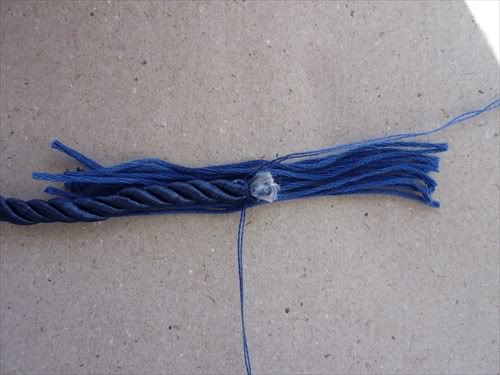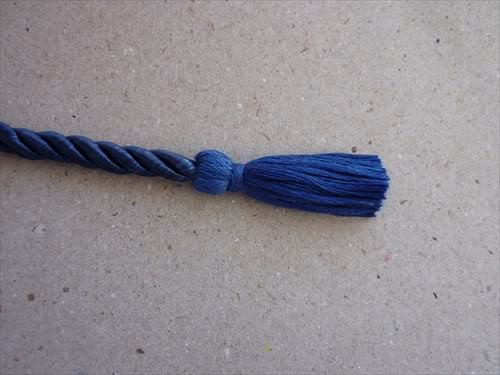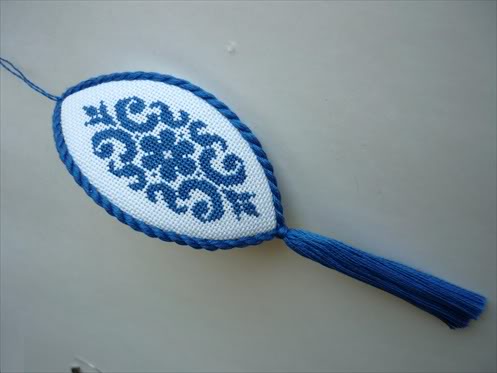To do this I fold a thread in half and loop it around the cording,

wrap the two strands of thread tightly around the cording, thread the two ends of onto a sharp needle and poke it under the wraps,

and through the cording.

I then use the blunt end of the needle to roughly comb out the strands.

I dampen and blot dry the end then gently comb it out with a wide tooth comb.

Finally I trim it off evenly.


Sometimes you'll notice that the exterior of the cording is not the same as the interior. The exterior may use shiny synthetic threads while the interior may be more like cotton string.

If a two toned tassel is not the look you were hoping for I will suggest two things you can do instead.
1/ Put a bead on the end.
Tape the end of the cording and thread the bead onto the cording.

Put a circle of glue on the cording. (I use FabriTac.)

Pull the bead over the sticky cording and leave to dry. (My tape fell off.)

When the glue is dry check that the bead seems secure. If not push it back up the cording, apply more glue, move the bead onto the glue and leave it to dry again. When the bead is secure you can trim the cording below the bead. (Note I would not consider this a child safe finish.)

2/ Make a tassel over the cording
This takes a bit more patience but it makes a nice finish.
Find some thread that matches, contrasts, or compliments the cording. I used 6 strand floss but Perle is another good choice.

Wrap the thread (I used two strands) around the cording two or three times, pull it very tight and knot the two ends of the thread together. (Try to leave the short end longer than the tassel will be so you can trim it when you trim the tassel.) Cut the cording about 1/4 inch below this wrap.

Cut a rectangle of cardboard slightly wider than you want your finished tassel. Wrap the thread around the cardboard. I wrapped it around 22 times.

Insert your scissors between the cardboard and thread and cut through all the threads.

Lay half the threads down on your work surface and lay the cording on top so it's wrap of thread is on the center of the pieces of thread.

Lay the rest of the pieces of thread on top of the cording.

Tightly wrap the long end of the thread around the pieces and the cording two or three times. Knot the two ends together.

Check that the pieces cover the cording all the way around. If they don't then try to shift them until they do. (Suggestion. To more securely fasten the tassel to the cording one could now thread the wrapping thread onto a sharp needle and push it through the wrapping and the cording.)
Fold the top half of the threads down and patiently smooth them out. Let the short end of the wrapping thread hang with the rest of the tassel but bring the long end neatly to the surface.

Wind the long end around once. Catch a loop with the end. Adjust this loop so it is about 1/4 inch below the fold of the threads.

Wind the long end around until you have a nice ring of thread around your tassel. Thread the long end(s) onto a needle. Insert the needle above the ring and bring it out in the middle of your tassel.


Dampen and smooth your tassel. Trim it to length.

As a variation to this one can bind the two ends of the commercial cording together and use pieces of thread (floss or Perle) to make a single tassel to cover the ends of the cording,

or make their own cording with a tasselled end. Click on the photo below to visit my tutorial for making a twisted cord with a tasseled end.


Pinwheel 2010 and 2012
